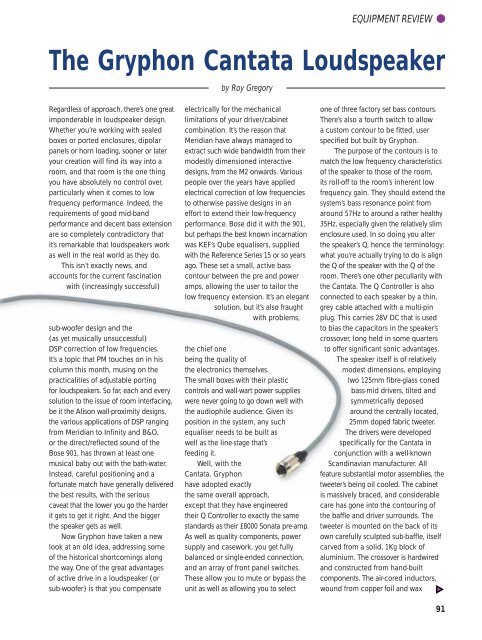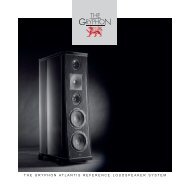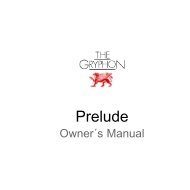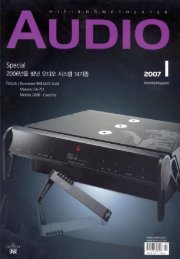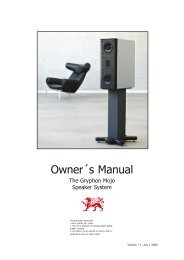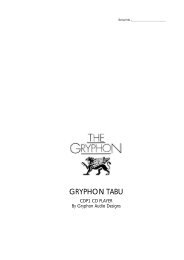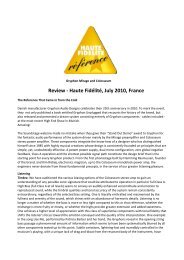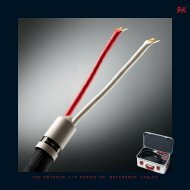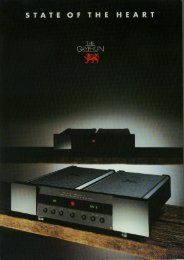Cantata - Gryphon Audio Designs
Cantata - Gryphon Audio Designs
Cantata - Gryphon Audio Designs
Create successful ePaper yourself
Turn your PDF publications into a flip-book with our unique Google optimized e-Paper software.
EQUIPMENT REVIEW<br />
The <strong>Gryphon</strong> <strong>Cantata</strong> Loudspeaker<br />
by Roy Gregory<br />
Regardless of approach, there’s one great<br />
imponderable in loudspeaker design.<br />
Whether you’re working with sealed<br />
boxes or ported enclosures, dipolar<br />
panels or horn loading, sooner or later<br />
your creation will find its way into a<br />
room, and that room is the one thing<br />
you have absolutely no control over,<br />
particularly when it comes to low<br />
frequency performance. Indeed, the<br />
requirements of good mid-band<br />
performance and decent bass extension<br />
are so completely contradictory that<br />
it’s remarkable that loudspeakers work<br />
as well in the real world as they do.<br />
This isn’t exactly news, and<br />
accounts for the current fascination<br />
with (increasingly successful)<br />
sub-woofer design and the<br />
(as yet musically unsuccessful)<br />
DSP correction of low frequencies.<br />
It’s a topic that PM touches on in his<br />
column this month, musing on the<br />
practicalities of adjustable porting<br />
for loudspeakers. So far, each and every<br />
solution to the issue of room interfacing,<br />
be it the Alison wall-proximity designs,<br />
the various applications of DSP ranging<br />
from Meridian to Infinity and B&O,<br />
or the direct/reflected sound of the<br />
Bose 901, has thrown at least one<br />
musical baby out with the bath-water.<br />
Instead, careful positioning and a<br />
fortunate match have generally delivered<br />
the best results, with the serious<br />
caveat that the lower you go the harder<br />
it gets to get it right. And the bigger<br />
the speaker gets as well.<br />
Now <strong>Gryphon</strong> have taken a new<br />
look at an old idea, addressing some<br />
of the historical shortcomings along<br />
the way. One of the great advantages<br />
of active drive in a loudspeaker (or<br />
sub-woofer) is that you compensate<br />
electrically for the mechanical<br />
limitations of your driver/cabinet<br />
combination. It’s the reason that<br />
Meridian have always managed to<br />
extract such wide bandwidth from their<br />
modestly dimensioned interactive<br />
designs, from the M2 onwards. Various<br />
people over the years have applied<br />
electrical correction of low frequencies<br />
to otherwise passive designs in an<br />
effort to extend their low-frequency<br />
performance. Bose did it with the 901,<br />
but perhaps the best known incarnation<br />
was KEF’s Qube equalisers, supplied<br />
with the Reference Series 15 or so years<br />
ago. These set a small, active bass<br />
contour between the pre and power<br />
amps, allowing the user to tailor the<br />
low frequency extension. It’s an elegant<br />
solution, but it’s also fraught<br />
with problems,<br />
the chief one<br />
being the quality of<br />
the electronics themselves.<br />
The small boxes with their plastic<br />
controls and wall-wart power supplies<br />
were never going to go down well with<br />
the audiophile audience. Given its<br />
position in the system, any such<br />
equaliser needs to be built as<br />
well as the line-stage that’s<br />
feeding it.<br />
Well, with the<br />
<strong>Cantata</strong>, <strong>Gryphon</strong><br />
have adopted exactly<br />
the same overall approach,<br />
except that they have engineered<br />
their Q Controller to exactly the same<br />
standards as their £8000 Sonata pre-amp.<br />
As well as quality components, power<br />
supply and casework, you get fully<br />
balanced or single-ended connection,<br />
and an array of front panel switches.<br />
These allow you to mute or bypass the<br />
unit as well as allowing you to select<br />
one of three factory set bass contours.<br />
There’s also a fourth switch to allow<br />
a custom contour to be fitted, user<br />
specified but built by <strong>Gryphon</strong>.<br />
The purpose of the contours is to<br />
match the low frequency characteristics<br />
of the speaker to those of the room,<br />
its roll-off to the room’s inherent low<br />
frequency gain. They should extend the<br />
system’s bass resonance point from<br />
around 57Hz to around a rather healthy<br />
35Hz, especially given the relatively slim<br />
enclosure used. In so doing you alter<br />
the speaker’s Q, hence the terminology:<br />
what you’re actually trying to do is align<br />
the Q of the speaker with the Q of the<br />
room. There’s one other peculiarity with<br />
the <strong>Cantata</strong>. The Q Controller is also<br />
connected to each speaker by a thin,<br />
grey cable attached with a multi-pin<br />
plug. This carries 28V DC that is used<br />
to bias the capacitors in the speaker’s<br />
crossover, long held in some quarters<br />
to offer significant sonic advantages.<br />
The speaker itself is of relatively<br />
modest dimensions, employing<br />
two 125mm fibre-glass coned<br />
bass-mid drivers, tilted and<br />
symmetrically deposed<br />
around the centrally located,<br />
25mm doped fabric tweeter.<br />
The drivers were developed<br />
specifically for the <strong>Cantata</strong> in<br />
conjunction with a well-known<br />
Scandinavian manufacturer. All<br />
feature substantial motor assemblies, the<br />
tweeter’s being oil cooled. The cabinet<br />
is massively braced, and considerable<br />
care has gone into the contouring of<br />
the baffle and driver surrounds. The<br />
tweeter is mounted on the back of its<br />
own carefully sculpted sub-baffle, itself<br />
carved from a solid, 1Kg block of<br />
aluminium. The crossover is hardwired<br />
and constructed from hand-built<br />
components. The air-cored inductors,<br />
wound from copper foil and wax<br />
91


